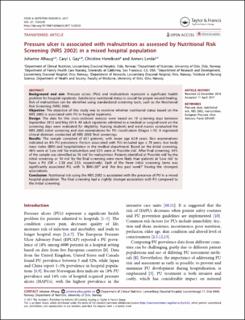| dc.contributor.author | Alhaug, Johanne | |
| dc.contributor.author | Gay, Caryl | |
| dc.contributor.author | Henriksen, Christine | |
| dc.contributor.author | Lerdal, Anners | |
| dc.date.accessioned | 2020-11-25T10:14:59Z | |
| dc.date.available | 2020-11-25T10:14:59Z | |
| dc.date.issued | 2017 | |
| dc.identifier.citation | Alhaug, J., Gay, C. L., Henriksen, C., & Lerdal, A. (2017). Pressure ulcer is associated with malnutrition as assessed by Nutritional Risk Screening (NRS 2002) in a mixed hospital population. Food & Nutrition Research, 61. | en_US |
| dc.identifier.issn | 1654-661X | |
| dc.identifier.uri | https://hdl.handle.net/11250/2689520 | |
| dc.description.abstract | Background and aim : Pressure ulcers (PUs) and malnutrition represent a significant health problem for hospital inpatients. Satisfactory nutritional status is crucial for proper wound healing. Risk of malnutrition can be identified using standardized screening tools, such as the Nutritional Risk Screening (NRS) 2002.
Objective : The objective of this study was to examine whether nutritional status based on the NRS 2002 is associated with PU in hospital inpatients.
Design : The data for this cross-sectional analysis were based on 10 screening days between September 2012 and May 2014. All adult inpatients admitted to a medical or surgical ward on the screening days were evaluated for eligibility. Nursing students and ward nurses conducted the NRS 2002 initial screening and skin examinations for PU classification (Stages I–IV). A registered clinical dietician conducted all NRS 2002 final screenings.
Results : The sample consisted of 651 patients, with mean age 62.9 years. Skin examinations indicated an 8% PU prevalence. Factors associated with PUs included age ≥ 70 years, low body mass index (BMI) and hospitalization in the medical department. Based on the initial screening, 48% were at ‘Low risk’ for malnutrition and 52% were at ‘Possible risk’. After final screening, 34% of the sample was identified as ‘At risk’ for malnutrition. Patients identified at ‘Possible risk’ by the initial screening or ‘At risk’ by the final screening were more likely than patients at ‘Low risk’ to have a PU (OR = 2.58 and 2.55, respectively). Each of the three initial screening items was significantly associated PU, with ‘Is BMI<20?’ and ‘Ate less past week?’ having the strongest associations.
Conclusion : Nutritional risk using the NRS 2002 is associated with the presence of PU in a mixed hospital population. The final screening had a slightly stronger association with PU compared to the initial screening. | en_US |
| dc.rights | Navngivelse-Ikkekommersiell 4.0 Internasjonal | * |
| dc.rights.uri | http://creativecommons.org/licenses/by-nc/4.0/deed.no | * |
| dc.subject | pressure ulcer | en_US |
| dc.subject | nutritional risk | en_US |
| dc.subject | NRS 2002 | en_US |
| dc.subject | malnutrition | en_US |
| dc.subject | European Pressure Ulcer Advisory Panel (EPUAP) | en_US |
| dc.subject | trykksår | en_US |
| dc.title | Pressure ulcer is associated with malnutrition as assessed by Nutritional Risk Screening (NRS 2002) in a mixed hospital population | en_US |
| dc.type | Journal article | en_US |
| dc.source.volume | 61 | en_US |
| dc.source.journal | Food & Nutrition Research (FNR) | en_US |
| dc.identifier.doi | https://doi.org/10.1080/16546628.2017.1324230 | |

